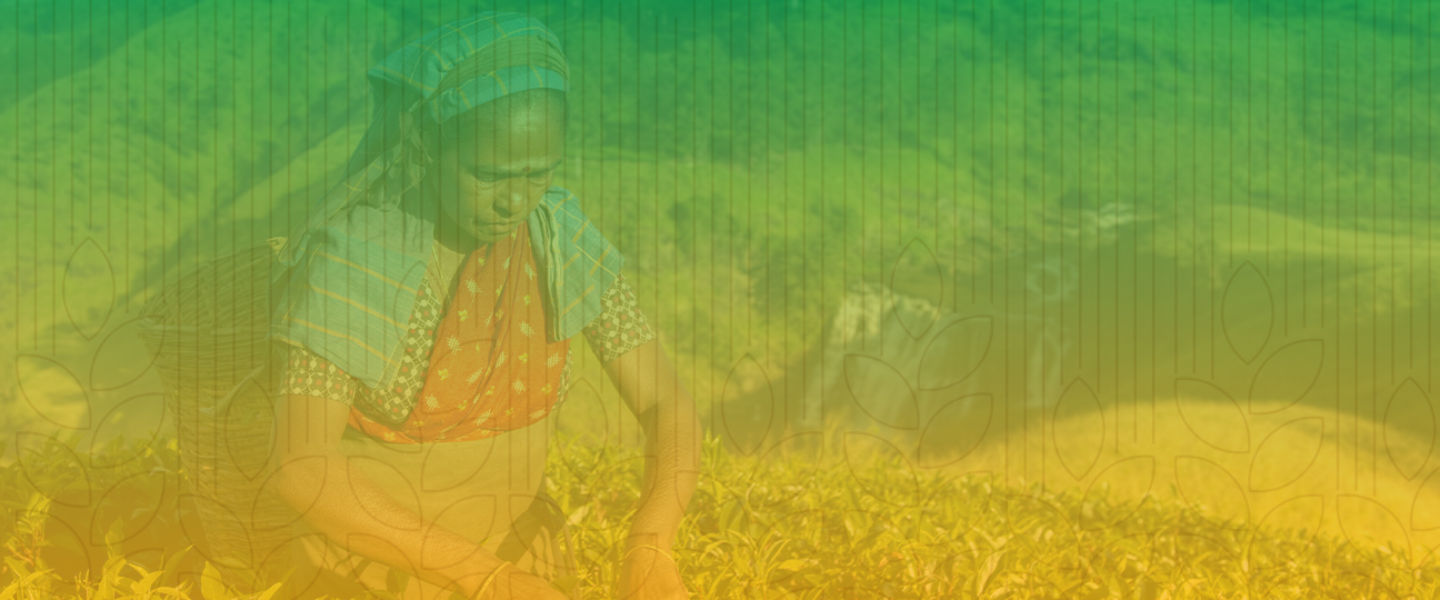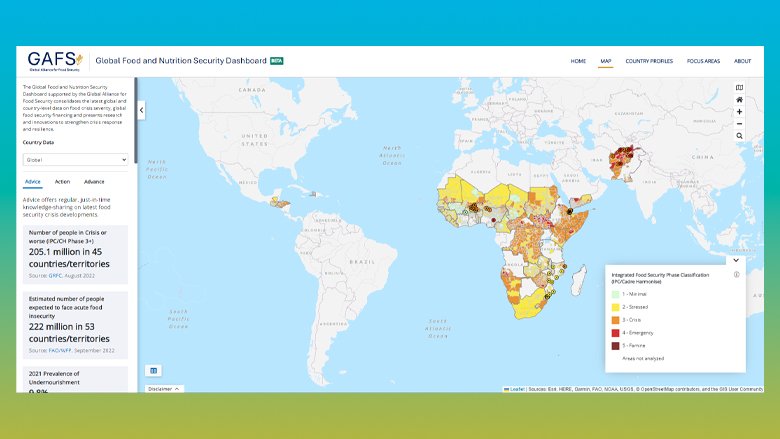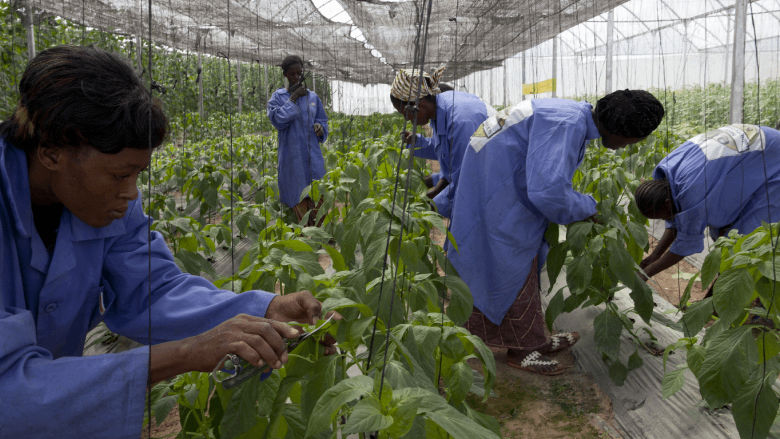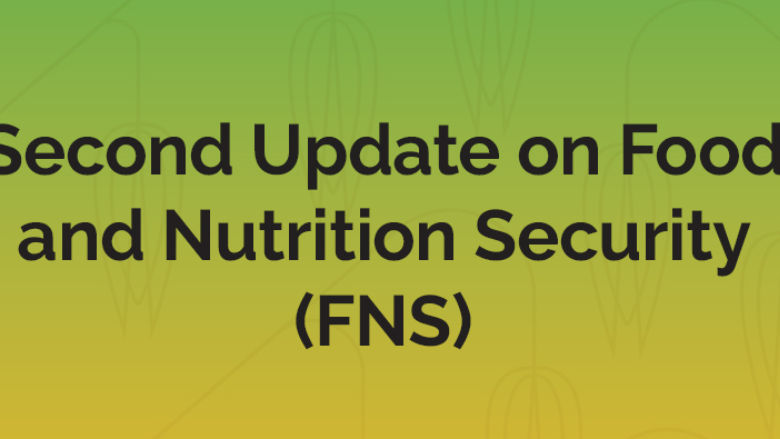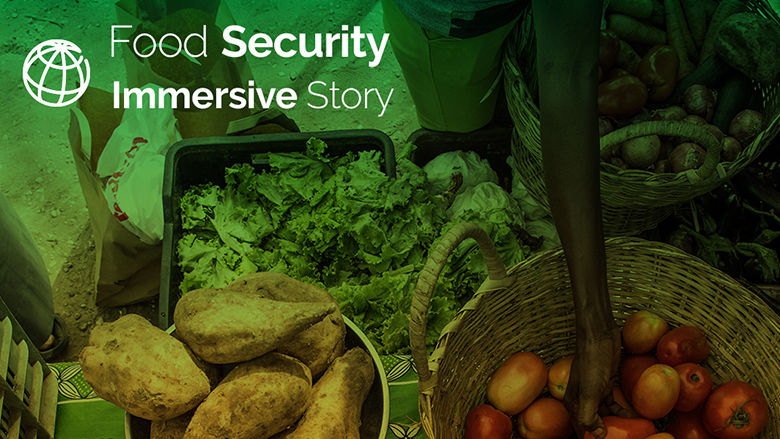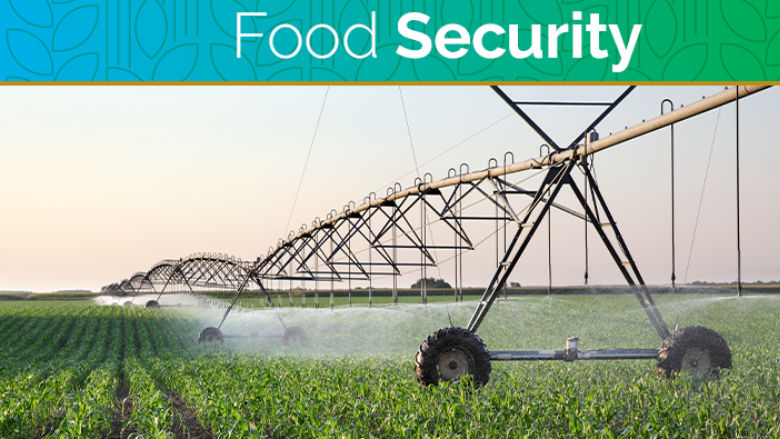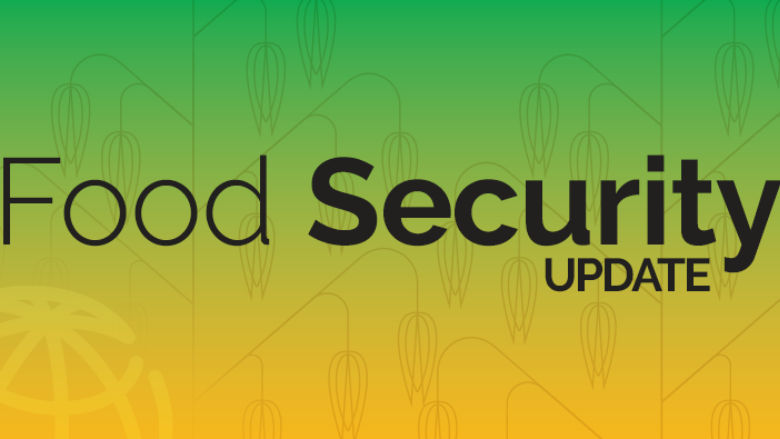Latest Update – April 15, 2024
Domestic food price inflation remains high. Inflation higher than 5% is experienced in 57.1% of low-income countries (a 2.9 percentage point decrease since the last update on March 28, 2024), 63.8% of lower-middle-income countries (no change), 36% percent of upper-middle-income countries (3.0 percentage points lower), and 21.8% of high-income countries (5.5 percentage points lower). In real terms, food price inflation exceeded overall inflation in 55.4% of 166 countries where data is available.
Download the latest brief on rising food insecurity and World Bank responses
Compared to two weeks ago, the agricultural and export price indices closed 3% higher and 8% higher, respectively, while the cereal price index closed at the same level. The export price index continues to be driven by increasing cocoa and coffee arabica prices. Among cereals, maize prices and rice prices were down 1%, while wheat prices closed 3% higher compared to two weeks ago. On a year-on-year basis, maize prices are 34% lower and wheat prices are 17% lower, rice prices on the other hand are 25% higher. Compared to January 2020, maize prices are 13% higher, wheat prices are 1% higher, and rice prices are 48% higher. (See “pink sheet” data for agricultural commodity and food commodity prices indices, updated monthly.)
The most recent Agricultural Market Information System (AMIS) market monitor highlighted a month-on-month decrease in wheat and rice export prices in March 2024. Coupled with a longer-term downward trajectory in maize prices, this is helping offset the rising costs of freight and insurance related to shipping disruptions for importers. Consequently, winter wheat plantings for the 2024 harvest decreased in Ukraine and the United States, although spring plantings may compensate for this in some regions. There may also be a shift from maize to soybeans as increasing crude oil prices boost prospects for biofuel demand. Although overall crop conditions by the end of March do not raise alarm, significant weather events could change this outlook.
Unhealthy ultra processed foods such as instant noodles and sodas are increasing in prevalence and affordability. Overconsumption leads to worse health outcomes, even in countries battling effects of undernutrition such as stunting and those with rapidly increasing obesity rates linked to noncommunicable diseases such as diabetes, cardiovascular disease, and cancer. Nutrition-targeted taxes are an effective fiscal tool with which to address the growing dominance of unhealthy foods and beverages by encouraging substitution of healthy alternatives. The main goal is to support healthy diets and population health, with a key co-benefit being the potential to raise additional tax revenue. These taxes can be even more effective when designed to encourage manufacturers to reformulate products, such as lower tax rates on low-sugar products or combined with measures to promote healthy foods and drinks, such as subsidies on fruits and vegetables.
Yemen’s second Joint Monitoring Report, published in March 2024, employs a sophisticated combination of quantitative modeling and qualitative analysis to provide comprehensive bimonthly monitoring of food and nutrition security (FNS), with a focus on identifying emerging crisis risks. This model, which uses data up to January 2024, provides a detailed analysis of the FNS situation in Yemen. The report highlights that approximately 2.5 million people in government- and Ansar Allah-controlled areas are living in areas at risk of deteriorating into Emergency or worse FNS conditions (IPC Phase 4+), consistent with previous modeling. Key indicators such as drought, exchange rates, displacement, and conflict risk have raised significant concern, underscoring the complex challenges facing the region.
Stakeholders in the FNS sector convened in Rome to foster collaboration between the World Bank and Rome-based agencies such as the Food and Agriculture Organization (FAO), World Food Programme (WFP), International Fund for Agricultural Development, and CGIAR. A key takeaway from the event was acknowledgment of the need to leverage partnerships and expand them beyond business as usual to facilitate strategic FNS engagements with client countries and private sector, bilateral, and multilateral partners.
Following Russia’s invasion of Ukraine, trade-related policies imposed by countries have surged. The global food crisis has been partially made worse by the growing number of food and fertilizer trade restrictions put in place by countries with a goal of increasing domestic supply and reducing prices. As of April 8, 2024, 16 countries have implemented 22 food export bans, and 8 have implemented 15 export-limiting measures.
World Bank Action
In May 2022, the World Bank made a commitment of making available $30 billion over a period of 15 months to tackle the crisis. We have surpassed that goal. The World Bank has scaled up its food and nutrition security response, to now making $45 billion available through a combination of $22 billion in new lending and $23 billion from existing portfolio.
Our food and nutrition security portfolio now spans across 90 countries. It includes both short term interventions such as expanding social protection, also longer-term resilience such as boosting productivity and climate-smart agriculture.
The Bank's intervention is expected to benefit 335 million people, equivalent to 44% of the number of undernourished people. Around 53% of the beneficiaries are women – they are disproportionately more affected by the crisis. Some examples include:
- In Honduras, the Rural Competitiveness Project series (COMRURAL II and III) aims to generate entrepreneurship and employment opportunities while promoting a climate-conscious, nutrition-smart strategy in agri-food value chains. To date, the program is benefiting around 6,287 rural small-scale producers (of which 33% are women, 15% youth, and 11% indigenous) of coffee, vegetables, dairy, honey, and other commodities through enhanced market connections and adoption of improved agricultural technologies and has created 6,678 new jobs.
- In Honduras, the Corredor Seco Food Security Project (PROSASUR) strives to enhance food security for impoverished and vulnerable rural households in the country’s Dry Corridor. This project has supported 12,202 extremely vulnerable families through nutrition-smart agricultural subprojects, food security plans, community nutrition plans, and nutrition and hygiene education. Within the beneficiary population, 70% of children under the age of five and their mothers now have a dietary diversity score of at least 4 (i.e., consume at least four food groups).
- The $2.75 billion Food Systems Resilience Program for Eastern and Southern Africa, helps countries in Eastern and Southern Africa increase the resilience of the region’s food systems and ability to tackle growing food insecurity. Now in phase three, the program will enhance inter-agency food crisis response also boost medium- and long-term efforts for resilient agricultural production, sustainable development of natural resources, expanded market access, and a greater focus on food systems resilience in policymaking.
- A $95 million credit from IDA for the Malawi Agriculture Commercialization Project (AGCOM) to increase commercialization of select agriculture value chain products and to provide immediate and effective response to an eligible crisis or emergency.
- The $200 million IDA grant for Madagascar to strengthen decentralized service delivery, upgrade water supply, restore and protect landscapes, and strengthen the resilience of food and livelihood systems in the drought-prone ‘Grand Sud’.
- A $60 million credit for the Integrated Community Development Project that works with refugees and host communities in four northern provinces of Burundi to improve food and nutrition security, build socio-economic infrastructure, and support micro-enterprise development through a participatory approach.
- The $175 million Sahel Irrigation Initiative Regional Support Project is helping build resilience and boost productivity of agricultural and pastoral activities in Burkina Faso, Chad, Mali, Mauritania, Niger, and Senegal. More than 130,000 farmers and members of pastoral communities are benefiting from small and medium-sized irrigation initiatives. The project is building a portfolio of bankable irrigation investment projects of around 68,000 ha, particularly in medium and large-scale irrigation in the Sahel region.
- Through the $50 million Emergency Food Security Response project, 329,000 smallholder farmers in Central Africa Republic have received seeds, farming tools and training in agricultural and post-harvest techniques to boost crop production and become more resilient to climate and conflict risks.
- The $15 million Guinea Bissau Emergency Food Security Project is helping increase agriculture production and access to food to vulnerable families. Over 72,000 farmers have received drought-resistant and high-yielding seeds, fertilizers, agricultural equipment; and livestock vaccines for the country-wide vaccination program. In addition, 8,000 vulnerable households have received cash transfer to purchase food and tackle food insecurity.
- The $60 million Accelerating the Impact of CGIAR Research for Africa (AICCRA) project has reached nearly 3 million African farmers (39% women) with critical climate smart agriculture tools and information services in partnership with the Consortium of International Agricultural Research Centers (CGIAR). These tools and services are helping farmers to increase production and build resilience in the face of climate crisis. In Mali, studies showed that farmers using recommendations from the AICCRA-supported RiceAdvice had on average 0.9 ton per hectare higher yield and US$320 per hectare higher income.
- The $766 million West Africa Food Systems Resilience Program is working to increase preparedness against food insecurity and improve the resilience of food systems in West Africa. The program is increasing digital advisory services for agriculture and food crisis prevention and management, boosting adaption capacity of agriculture system actors, and investing in regional food market integration and trade to increase food security. An additional $345 million is currently under preparation for Senegal, Sierra Leone and Togo.
- A $150 million grant for the second phase of the Yemen Food Security Response and Resilience Project, which will help address food insecurity, strengthen resilience and protect livelihoods.
- $50 million grant of additional financing for Tajikistan to mitigate food and nutrition insecurity impacts on households and enhance the overall resilience of the agriculture sector.
- A $125 million project in Jordan aims to strengthen the development the agriculture sector by enhancing its climate resilience, increasing competitiveness and inclusion, and ensuring medium- to long-term food security.
- A $300 million project in Bolivia that will contribute to increasing food security, market access and the adoption of climate-smart agricultural practices.
- A $315 million loan to support Chad, Ghana and Sierra Leone to increase their preparedness against food insecurity and to improve the resilience of their food systems.
- A $500 million Emergency Food Security and Resilience Support Project to bolster Egypt's efforts to ensure that poor and vulnerable households have uninterrupted access to bread, help strengthen the country's resilience to food crises, and support to reforms that will help improve nutritional outcomes.
- A $130 million loan for Tunisia, seeking to lessen the impact of the Ukraine war by financing vital soft wheat imports and providing emergency support to cover barley imports for dairy production and seeds for smallholder farmers for the upcoming planting season.
In May 2022, the World Bank Group and the G7 Presidency co-convened the Global Alliance for Food Security, which aims to catalyze an immediate and concerted response to the unfolding global hunger crisis. The Alliance has developed the publicly accessible Global Food and Nutrition Security Dashboard, which provides timely information for global and local decision-makers to help improve coordination of the policy and financial response to the food crisis.
The heads of the FAO, IMF, World Bank Group, WFP, and WTO released a Third Joint Statement on February 8, 2023. The statement calls to prevent a worsening of the food and nutrition security crisis, further urgent actions are required to (i) rescue hunger hotspots, (ii) facilitate trade, improve the functioning of markets, and enhance the role of the private sector, and (iii) reform and repurpose harmful subsidies with careful targeting and efficiency. Countries should balance short-term urgent interventions with longer-term resilience efforts as they respond to the crisis.
Last Updated: Apr 15, 2024

